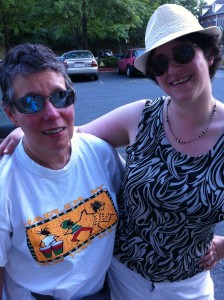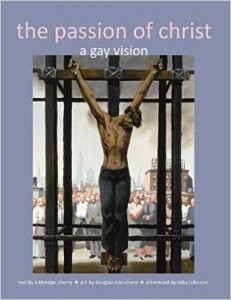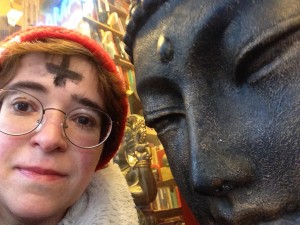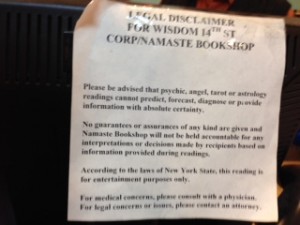Happy February, readers! It’s a leap year, so we get an “extra” day. For hard-headed moderns, it’s only a bureaucratic quirk of the calendar, a minor annoyance to remember to write February 29 instead of March 1 on our checks. For the magically minded, it could be an opportunity to step out of chronos into kairos, an auspicious day to envision goals and abilities beyond our here-and-now limitations, and maybe do a ritual to support that intention. For me, it’ll probably mean a day’s reprieve from the negative self-talk: “It’s already March and I haven’t [cleaned my office, finished my short story collection, won the Pulitzer Prize]!!”
In reality, we have as much time as we have, no matter how we divide up the calendar. Nowadays I’m constantly balancing how much time to give my own writing versus time to read and support other writers. Sometimes I’m fortunate to come across articles that not only educate and entertain me, but re-equip me to do my own work with more self-acceptance and insight. Let me share a couple of those with you.
Ozy’s blog Thing of Things offers a unique perspective on neurodiversity, sexuality and gender, and utilitarian ethics. With a fine-tuned analytical mind and humble self-aware humor, Ozy picks out the inconsistencies and complex side effects of our ideologies, yet adopts a “live and let live” attitude to everyone’s imperfect efforts to discover what happiness means to them.
One interesting fact I learned from Ozy is that there are people who identify as “otherkin”: they believe they are part animal, analogous to a genderqueer person believing they are partially male and partially female. In their January 25 post, “On Otherkin and Trans People”, Ozy disputes the argument that otherkin make transgender people seem less credible. I love this post because it basically sums up my philosophy of respecting people to be the authority on their own experience. Ozy’s logic also applies to those who disbelieve trauma survivors because their stories are not perfect in every factual detail, or because their reported experience sounds too grotesque and extreme to be true. (Boldface below is mine.)
As an advocate for the rights of trans people and neurodivergent people, I think the world would be a better place if we all collectively adopted this rule: if someone is being kinda weird, but they are not causing direct, measurable harm to anyone else, leave them alone and move on with your life.
Imagine if instead of harassing trans women on the street, people said, “well, that outfit’s rather odd, but it’s really none of my business.” Imagine if instead of discriminating against trans people in housing or the workplace, people said, “well, I can’t imagine why a man would want to be a woman, but she does good work and pays her rent on time and that’s what matters.” Imagine if no one ever wrote a long screed explaining why you are secretly a girl pretending to be a boy because of your traumatic past, your internalized homophobia, or your deep-seated desire to be Special.
Furthermore, I think we should all adopt the rule: if someone is describing an experience that is really fucking weird, your default assumption should be that they aren’t making it up.
Of course, that doesn’t mean they’re describing their experiences accurately, or their explanation of why they feel the way they do is worth a pound of dog shit, or that no one ever makes anything up. But start from the assumption that– however distorted– the person is doing their best to describe something that is actually happening in their lives, and that if you’re going to keep interacting with them, you should listen.
I mean, shit, if people responded to gender dysphoria with “I don’t get it, huh, brains are weird” rather than “I don’t get it, you must be faking and I am going to come up with all kinds of elaborate reasons to explain why”, transphobia would basically be solved.
Consider the costs and benefits of these rules. If otherkin is not a real thing and you leave them alone, then you weren’t a dick to someone who’s going to feel really silly in a couple of years. If otherkin is not a real thing and you listen, then you didn’t make them become defensive or feel like they couldn’t question their identity without being attacked, and maybe you helped them come to the realization that it isn’t real. If otherkin is a real thing and you don’t follow my rules, then you took someone going through a tremendously painful experience and made it worse for no reason.
Continuing on the theme of identity and inclusion, progressive theologian and seminary student Daniel José Camacho finds an ethic of radical welcome in the description of the Trinitarian Logos in the first chapter of the Gospel of John. In this January 5 article from The Christian Century, “John’s prologue and God’s rejected children”, Camacho finds it significant that “in the midst of rejection, the text also speaks about this rejected one giving power to people to become children of God on a basis that transcends biology and purity.”
The borderless nature of God’s manifestation in Jesus helped Camacho make sense of his hybrid identity as a second-generation Afro-Colombian immigrant, and become an ally to LGBTQ Christians whose families rejected them for so-called Biblical reasons. “While the text was saying that being a child of God was based on faith and not based on blood or procreation, I saw many churches basing faithful Christian identity precisely on biology, on heteronormativity, on the ability to procreate in a ‘heterosexual’ marriage.”
Later on in the essay, Camacho notes parallels between John’s Holy Spirit and the female-personified Sophia (Wisdom) of Jewish tradition, to suggest that the Logos is genderqueer:
Whether John intended it or not, I see the Logos as enacting a gender-bending performance. The man Jesus Christ who is the eternal Logos was/is also thewoman Sophia. This is a good reminder that God transcends the gender binaries and essentialisms that humans have sharply defined. John’s prologue depicts Jesus as transgressing not only what distinguishes the human and the divine, but transgressing gender norms. As such, I think it is right to see Jesus as a transgressive “border-crosser” in multiple ways. For some time now, feminist scholars such as Elizabeth A. Johnson have highlighted the importance of Sophia in Christological gender-dynamics. Is it a stretch to see the Logos as bending gender? I don’t think so. If we consider the rest of the prologue, the rest of John’s Gospel, and the rest of Jesus’ life, this is consistent. Jesus’ family is non-traditional; it is not based on simple “biology.” Jesus’ life is not necessarily emblematic of a “straight” lifestyle…
…Logos Christology needs to be unhooked from the Eurocentric rationality of the West which has sexually, racially, and economically classified people so as to produce and reproduce rejection and inequality.
In the Incarnation, the Word experiences the “No’s” that some of us hear. No, you are not truly American enough. No, you are not Latin American enough. No, you are not sexually normal. No, your societies are not developed. No, your culture/civilization is not rational enough. Entering into humanity’s rejection of itself, the Word then demolishes the harmful ways in which we have internalized purity, nationalistic and gendered essentialisms, and Eurocentric rationality to define what it means to be human. As such, the Logos is the disordering ordering principle who destabilizes the violent means by which we narrowly define humanity and carry out rejections of our own people and peoples around the world. The Wisdom of God is not the progression of rationality from the Greeks to the Romans to the Europeans to the United States. Sophia is the disordering ordering force of life who deconstructs what we deem “natural” in order to make room for a creation that is different and far richer than we imagined.
At the online magazine Mask, Johanna Hedva’s manifesto “Sick Woman Theory” is a long-read well worth your time. To a lesser degree than the author, I also struggle with chronic disability from endometriosis, compounded by the shame and silence that society wraps around “female troubles”. Hedva re-frames the conversation around disability and political resistance, arguing that the activism of personal survival is as valuable as anything that happens on the barricades. I like how she uses “woman” as a nonbinary symbol of solidarity with all marginalized bodies.
Sick Woman Theory is an insistence that most modes of political protest are internalized, lived, embodied, suffering, and no doubt invisible. Sick Woman Theory redefines existence in a body as something that is primarily and always vulnerable, following from Judith Butler’s work on precarity and resistance. Because the premise insists that a body is defined by its vulnerability, not temporarily affected by it, the implication is that it is continuously reliant on infrastructures of support in order to endure, and so we need to re-shape the world around this fact. Sick Woman Theory maintains that the body and mind are sensitive and reactive to regimes of oppression – particularly our current regime of neoliberal, white-supremacist, imperial-capitalist, cis-hetero-patriarchy. It is that all of our bodies and minds carry the historical trauma of this, that it is the world itself that is making and keeping us sick.
To take the term “woman” as the subject-position of this work is a strategic, all-encompassing embrace and dedication to the particular, rather than the universal. Though the identity of “woman” has erased and excluded many (especially women of color and trans and genderfluid people), I choose to use it because it still represents the un-cared for, the secondary, the oppressed, the non-, the un-, the less-than. The problematics of this term will always require critique, and I hope that Sick Woman Theory can help undo those in its own way. But more than anything, I’m inspired to use the word “woman” because I saw this year how it can still be radical to be a woman in the 21st century. I use it to honor a dear friend of mine who came out as genderfluid last year. For her, what mattered the most was to be able to call herself a “woman,” to use the pronouns “she/her.” She didn’t want surgery or hormones; she loved her body and her big dick and didn’t want to change it – she only wanted the word. That the word itself can be an empowerment is the spirit in which Sick Woman Theory is named.
The Sick Woman is an identity and body that can belong to anyone denied the privileged existence – or the cruelly optimistic promise of such an existence – of the white, straight, healthy, neurotypical, upper and middle-class, cis- and able-bodied man who makes his home in a wealthy country, has never not had health insurance, and whose importance to society is everywhere recognized and made explicit by that society; whose importance and care dominates that society, at the expense of everyone else.
The Sick Woman is anyone who does not have this guarantee of care.
The Sick Woman is told that, to this society, her care, even her survival, does not matter.
The Sick Woman is all of the “dysfunctional,” “dangerous” and “in danger,” “badly behaved,” “crazy,” “incurable,” “traumatized,” “disordered,” “diseased,” “chronic,” “uninsurable,” “wretched,” “undesirable” and altogether “dysfunctional” bodies belonging to women, people of color, poor, ill, neuro-atypical, differently abled, queer, trans, and genderfluid people, who have been historically pathologized, hospitalized, institutionalized, brutalized, rendered “unmanageable,” and therefore made culturally illegitimate and politically invisible.
The Sick Woman is a black trans woman having panic attacks while using a public restroom, in fear of the violence awaiting her.
The Sick Woman is the child of parents whose indigenous histories have been erased, who suffers from the trauma of generations of colonization and violence.
The Sick Woman is a homeless person, especially one with any kind of disease and no access to treatment, and whose only access to mental-health care is a 72-hour hold in the county hospital.
The Sick Woman is a mentally ill black woman whose family called the police for help because she was suffering an episode, and who was murdered in police custody, and whose story was denied by everyone operating under white supremacy. Her name is Tanesha Anderson.
The Sick Woman is a 50-year-old gay man who was raped as a teenager and has remained silent and shamed, believing that men can’t be raped.
The Sick Woman is a disabled person who couldn’t go to the lecture on disability rights because it was held in a venue without accessibility.
The Sick Woman is a white woman with chronic illness rooted in sexual trauma who must take painkillers in order to get out of bed.
The Sick Woman is a straight man with depression who’s been medicated (managed) since early adolescence and now struggles to work the 60 hours per week that his job demands.
The Sick Woman is someone diagnosed with a chronic illness, whose family and friends continually tell them they should exercise more.
The Sick Woman is a queer woman of color whose activism, intellect, rage, and depression are seen by white society as unlikeable attributes of her personality.
The Sick Woman is a black man killed in police custody, and officially said to have severed his own spine. His name is Freddie Gray.
The Sick Woman is a veteran suffering from PTSD on the months-long waiting list to see a doctor at the VA.
The Sick Woman is a single mother, illegally emigrated to the “land of the free,” shuffling between three jobs in order to feed her family, and finding it harder and harder to breathe.
The Sick Woman is the refugee.
The Sick Woman is the abused child.
The Sick Woman is the person with autism whom the world is trying to “cure.”
The Sick Woman is the starving.
The Sick Woman is the dying.
And, crucially: The Sick Woman is who capitalism needs to perpetuate itself.
Why?
Because to stay alive, capitalism cannot be responsible for our care – its logic of exploitation requires that some of us die.
“Sickness” as we speak of it today is a capitalist construct, as is its perceived binary opposite, “wellness.” The “well” person is the person well enough to go to work. The “sick” person is the one who can’t. What is so destructive about conceiving of wellness as the default, as the standard mode of existence, is that it invents illness as temporary. When being sick is an abhorrence to the norm, it allows us to conceive of care and support in the same way.
Care, in this configuration, is only required sometimes. When sickness is temporary, care is not normal.
Here’s an exercise: go to the mirror, look yourself in the face, and say out loud: “To take care of you is not normal. I can only do it temporarily.”
Saying this to yourself will merely be an echo of what the world repeats all the time…
…The most anti-capitalist protest is to care for another and to care for yourself. To take on the historically feminized and therefore invisible practice of nursing, nurturing, caring. To take seriously each other’s vulnerability and fragility and precarity, and to support it, honor it, empower it. To protect each other, to enact and practice community. A radical kinship, an interdependent sociality, a politics of care.






